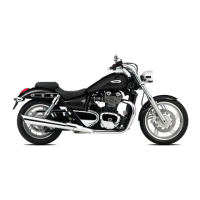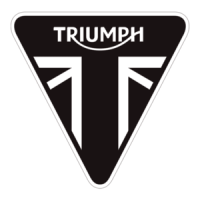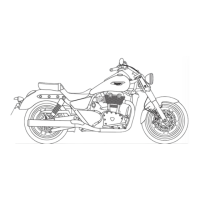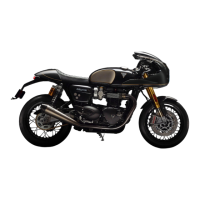Do you have a question about the Triumph Thunderbird LT and is the answer not in the manual?
Thanks the customer, advises reading the handbook for correct operation and safety tips.
Warns about gasoline flammability and hazardous exhaust fumes.
Advises on wearing appropriate protective gear, including helmets, eye protection, gloves, and clothing.
Advises using only approved parts and accessories installed by authorized dealers.
Provides essential riding advice, including avoiding fatigue, alcohol, and proper licensing.
Illustrates and labels the motorcycle's instrument panel indicators and gauges.
Explains the meaning and function of various warning lights on the instrument panel.
Details the engine management system malfunction indicator light and its implications.
Explains the ABS warning light, its normal operation, and fault indication.
Details the ignition key, transponder function, and key security.
Details the function of the engine stop switch, starter button, and scroll button.
Explains the headlight dimmer switch, turn signal switch, and horn button.
Specifies fuel grade, octane rating, and precautions for refuelling.
Explains the breaking-in process for new motorcycles to ensure longevity and performance.
Outlines daily safety checks required before riding the motorcycle.
Provides instructions for safely stopping the motorcycle engine.
Details the procedure for starting the motorcycle engine, including checks and notes.
Explains how to move off from a standstill, including clutch and throttle control.
Describes how to shift gears smoothly and safely using the clutch and gear pedal.
Provides essential advice on braking techniques, including applying both brakes.
Explains the ABS warning light, its normal operation, and fault indication.
Warns about the dangers of high-speed operation and necessary precautions.
Stresses passenger height for reaching footrests to ensure stability and prevent accidents.
Outlines the importance of scheduled maintenance and different service intervals.
Explains the importance of maintaining correct engine oil levels.
Provides instructions for checking the engine oil level using the dipstick.
Step-by-step guide for changing the engine oil and oil filter.
Covers brake wear inspection and replacement of brake pads.
Stresses the importance of checking and maintaining correct tire inflation pressures.
Warns about damaged tires, incorrect balancing, and improper tube use hazards.
Covers battery removal, safety warnings, and precautions.
Details steps for preparing the motorcycle for storage, including fuel and battery care.
Outlines the steps required to prepare the motorcycle for riding after storage.
Thanks the customer, advises reading the handbook for correct operation and safety tips.
Warns about gasoline flammability and hazardous exhaust fumes.
Advises on wearing appropriate protective gear, including helmets, eye protection, gloves, and clothing.
Advises using only approved parts and accessories installed by authorized dealers.
Provides essential riding advice, including avoiding fatigue, alcohol, and proper licensing.
Illustrates and labels the motorcycle's instrument panel indicators and gauges.
Explains the meaning and function of various warning lights on the instrument panel.
Details the engine management system malfunction indicator light and its implications.
Explains the ABS warning light, its normal operation, and fault indication.
Details the ignition key, transponder function, and key security.
Details the function of the engine stop switch, starter button, and scroll button.
Explains the headlight dimmer switch, turn signal switch, and horn button.
Specifies fuel grade, octane rating, and precautions for refuelling.
Explains the breaking-in process for new motorcycles to ensure longevity and performance.
Outlines daily safety checks required before riding the motorcycle.
Provides instructions for safely stopping the motorcycle engine.
Details the procedure for starting the motorcycle engine, including checks and notes.
Explains how to move off from a standstill, including clutch and throttle control.
Describes how to shift gears smoothly and safely using the clutch and gear pedal.
Provides essential advice on braking techniques, including applying both brakes.
Explains the ABS warning light, its normal operation, and fault indication.
Warns about the dangers of high-speed operation and necessary precautions.
Stresses passenger height for reaching footrests to ensure stability and prevent accidents.
Outlines the importance of scheduled maintenance and different service intervals.
Explains the importance of maintaining correct engine oil levels.
Provides instructions for checking the engine oil level using the dipstick.
Step-by-step guide for changing the engine oil and oil filter.
Covers brake wear inspection and replacement of brake pads.
Stresses the importance of checking and maintaining correct tire inflation pressures.
Warns about damaged tires, incorrect balancing, and improper tube use hazards.
Covers battery removal, safety warnings, and precautions.
Details steps for preparing the motorcycle for storage, including fuel and battery care.
Outlines the steps required to prepare the motorcycle for riding after storage.
| Displacement | 1699 cc |
|---|---|
| Bore x Stroke | 107.1 mm x 94.3 mm |
| Compression Ratio | 9.7:1 |
| Final Drive | Belt |
| Clutch | Wet, multi-plate |
| Gearbox | 6-speed |
| Frame | Tubular steel, twin spine |
| Rear Tyre | 180/70 R16 |
| Engine Type | Parallel twin |
| Max Power | 94 PS / 93 bhp / 69 kW @ 5, 400 rpm |
| Max Torque | 151 Nm |
| Fuel System | Sequential multipoint electronic fuel injection |
| Exhaust | Chrome 2-into-1-into-2 |
| Front Suspension | Showa 47mm forks, 120mm travel |
| Rear Suspension | Showa twin shocks with 5 position adjustable preload, 95mm rear wheel travel |
| Front Brakes | Dual 310mm floating discs, Nissin 4-piston calipers, ABS |
| Rear Brakes | Single 310mm disc, Brembo 2-piston caliper, ABS |
| Front Wheel | 16 x 3.5 in |
| Rear Wheel | 16 x 5.0 in |
| Seat Height | 700 mm |
| Fuel Tank Capacity | 22 litres |












